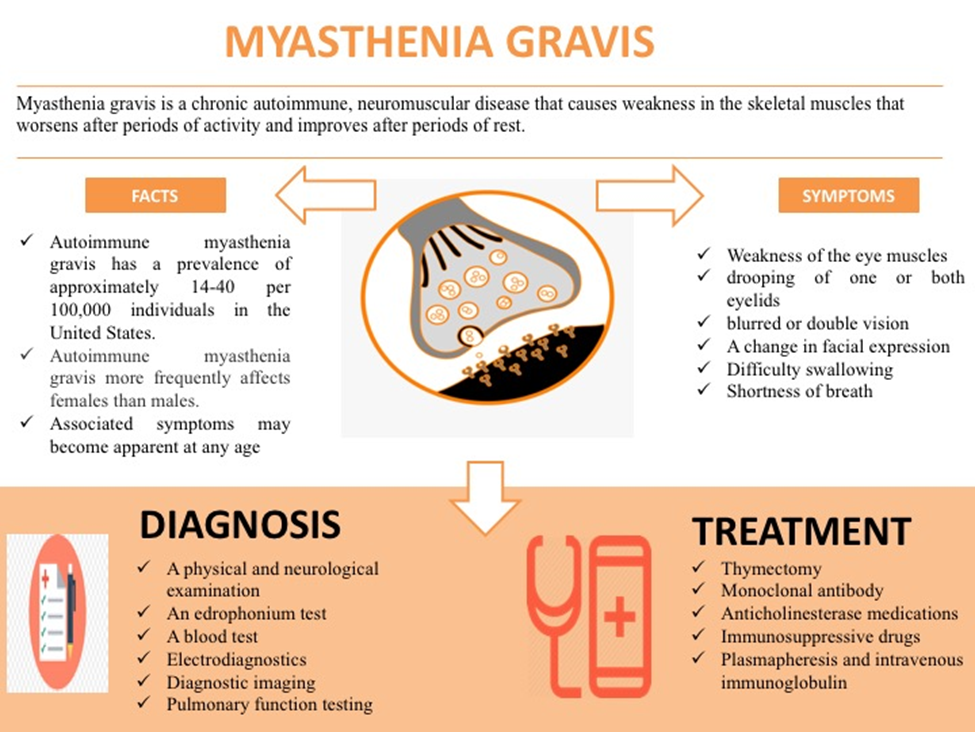A patient is receiving a dose of edrophonium. The nurse recognizes that this drug is given to determine the diagnosis of which disease?
Parkinson's disease
Alzheimer's disease
Myasthenia Gravis
Serotonin Syndrome
The Correct Answer is C
A. Parkinson's disease
Edrophonium is not used for the diagnosis of Parkinson's disease. Parkinson's disease is a neurodegenerative disorder characterized by motor symptoms such as tremors, rigidity, and bradykinesia. The diagnosis is typically based on clinical symptoms and neurological examination.
B. Alzheimer's disease
Edrophonium is not used for the diagnosis of Alzheimer's disease. Alzheimer's disease is a progressive neurodegenerative disorder affecting cognition. The diagnosis involves clinical evaluation, cognitive assessments, and sometimes imaging studies, but not the use of edrophonium.
C. Myasthenia Gravis
This is the correct choice. Edrophonium is used as a diagnostic tool in Myasthenia Gravis. In individuals with Myasthenia Gravis, the administration of edrophonium can lead to a temporary improvement in muscle strength, helping to confirm the diagnosis.
D. Serotonin Syndrome
Edrophonium is not used for the diagnosis of serotonin syndrome. Serotonin syndrome is a condition caused by an excess of serotonin, often due to the use of certain medications. Diagnosis is based on clinical symptoms and a history of serotonin-affecting medications, not the administration of edrophonium.

Nursing Test Bank
Naxlex Comprehensive Predictor Exams
Related Questions
Correct Answer is C
Explanation
A. As requested by the patient.
Administering the drug only when requested by the patient may not provide adequate prophylaxis against chemotherapy-induced nausea and vomiting. These medications are often prescribed on a schedule to prevent symptoms rather than treating them reactively.
B. 1 hour after chemotherapy administration.
Waiting until 1 hour after chemotherapy administration may not cover the full period during which nausea and vomiting are likely to occur. The administration schedule for antiemetics is often more extended to provide better coverage.
C. The night before the treatment, the day of the treatment, and for 24 hours after the treatment.
This is the correct choice. Administering phenothiazine antiemetics according to this schedule helps ensure continuous coverage during the critical period when chemotherapy-induced nausea and vomiting are most likely to occur.
D. The day of treatment.
Administering the drug only on the day of treatment may not provide sufficient coverage for the entire duration when chemotherapy-induced nausea and vomiting can occur. Again, the schedule mentioned in option C is more comprehensive for prevention.
Correct Answer is C
Explanation
A. "You will need to take an anticonvulsant of some type for your lifetime."
This statement may be accurate for some individuals with chronic or recurrent seizure disorders, but it is a generalization. The duration of anticonvulsant therapy varies from person to person, and some individuals may eventually be able to discontinue medication under the guidance of their healthcare provider.
B. "This medication should be taken until you haven't had a seizure for a month."
While seizure control is a factor in determining the duration of treatment, setting a specific timeframe (e.g., one month) may not be applicable to everyone. The decision to continue or discontinue anticonvulsant therapy is usually individualized and based on various factors, including the type of seizure disorder and the individual's response to treatment.
C. "Seizures are unpredictable and so is the duration of the treatment."
This is the best response. It acknowledges the variability in seizure disorders and the individualized nature of treatment duration. Seizure management is often an ongoing process that requires monitoring and adjustments based on the person's specific circumstances.
D. "You will only need to take it for a short period of time because anticonvulsants will cure the seizure disorder."
Anticonvulsants are typically used to manage and control seizures rather than cure the underlying seizure disorder. While some individuals may experience a period of seizure freedom and be able to discontinue medication, this is not true for everyone. The duration of treatment varies, and some individuals may require long-term or even lifelong therapy.
Whether you are a student looking to ace your exams or a practicing nurse seeking to enhance your expertise , our nursing education contents will empower you with the confidence and competence to make a difference in the lives of patients and become a respected leader in the healthcare field.
Visit Naxlex, invest in your future and unlock endless possibilities with our unparalleled nursing education contents today
Report Wrong Answer on the Current Question
Do you disagree with the answer? If yes, what is your expected answer? Explain.
Kindly be descriptive with the issue you are facing.
